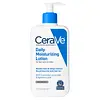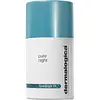What's inside
What's inside
 Key Ingredients
Key Ingredients

 Benefits
Benefits

 Concerns
Concerns

 Ingredients Side-by-side
Ingredients Side-by-side

Water
Skin ConditioningGlycerin
HumectantCaprylic/Capric Triglyceride
MaskingCetearyl Alcohol
EmollientCetyl Alcohol
EmollientPotassium Phosphate
BufferingCeramide NP
Skin ConditioningCeramide AP
Skin ConditioningCeramide EOP
Skin ConditioningCarbomer
Emulsion StabilisingDimethicone
EmollientCeteareth-20
CleansingBehentrimonium Methosulfate
Methylparaben
PreservativeSodium Lauroyl Lactylate
EmulsifyingCholesterol
EmollientDisodium EDTA
Dipotassium Phosphate
BufferingPropylparaben
PreservativeHydrolyzed Hyaluronic Acid
HumectantPhytosphingosine
Skin ConditioningXanthan Gum
EmulsifyingPolysorbate 20
EmulsifyingPolyglyceryl-3 Diisostearate
EmulsifyingWater, Glycerin, Caprylic/Capric Triglyceride, Cetearyl Alcohol, Cetyl Alcohol, Potassium Phosphate, Ceramide NP, Ceramide AP, Ceramide EOP, Carbomer, Dimethicone, Ceteareth-20, Behentrimonium Methosulfate, Methylparaben, Sodium Lauroyl Lactylate, Cholesterol, Disodium EDTA, Dipotassium Phosphate, Propylparaben, Hydrolyzed Hyaluronic Acid, Phytosphingosine, Xanthan Gum, Polysorbate 20, Polyglyceryl-3 Diisostearate
Water
Skin ConditioningCyclopentasiloxane
EmollientMethylheptyl Isostearate
Skin ConditioningButylene Glycol
HumectantDimethicone
EmollientCetyl Alcohol
EmollientIsohexadecane
EmollientCetearyl Alcohol
EmollientGlyceryl Stearate Citrate
EmollientCetearyl Ethylhexanoate
EmollientCetyl Caprylate
EmollientRubus Idaeus Seed Oil
EmollientVaccinium Macrocarpon Seed Oil
Skin ConditioningVigna Aconitifolia Seed Extract
Skin ConditioningStrelitzia Nicolai Seed Aril Extract
Skin ConditioningOligopeptide-34
Skin ConditioningLactobacillus/Pumpkin Fruit Ferment Filtrate
Skin ConditioningMagnesium Ascorbyl Phosphate
AntioxidantNiacinamide
SmoothingCananga Odorata Flower Oil
MaskingTocopherol
AntioxidantBeta-Sitosterol
Emulsion StabilisingZinc Glycinate
BufferingDecyl Glucoside
CleansingPolysilicone-11
Sodium Cocoyl Glutamate
CleansingDipotassium Glycyrrhizate
HumectantHydrogenated Phosphatidylcholine
EmulsifyingPotassium Cetyl Phosphate
EmulsifyingGlyceryl Caprylate
EmollientDimethicone Crosspolymer
Emulsion StabilisingDimethiconol
EmollientAcrylates/C10-30 Alkyl Acrylate Crosspolymer
Emulsion StabilisingAminomethyl Propanol
BufferingDisodium EDTA
Ethylhexylglycerin
Skin ConditioningPhenoxyethanol
PreservativeWater, Cyclopentasiloxane, Methylheptyl Isostearate, Butylene Glycol, Dimethicone, Cetyl Alcohol, Isohexadecane, Cetearyl Alcohol, Glyceryl Stearate Citrate, Cetearyl Ethylhexanoate, Cetyl Caprylate, Rubus Idaeus Seed Oil, Vaccinium Macrocarpon Seed Oil, Vigna Aconitifolia Seed Extract, Strelitzia Nicolai Seed Aril Extract, Oligopeptide-34, Lactobacillus/Pumpkin Fruit Ferment Filtrate, Magnesium Ascorbyl Phosphate, Niacinamide, Cananga Odorata Flower Oil, Tocopherol, Beta-Sitosterol, Zinc Glycinate, Decyl Glucoside, Polysilicone-11, Sodium Cocoyl Glutamate, Dipotassium Glycyrrhizate, Hydrogenated Phosphatidylcholine, Potassium Cetyl Phosphate, Glyceryl Caprylate, Dimethicone Crosspolymer, Dimethiconol, Acrylates/C10-30 Alkyl Acrylate Crosspolymer, Aminomethyl Propanol, Disodium EDTA, Ethylhexylglycerin, Phenoxyethanol
 Reviews
Reviews

Ingredients Explained
These ingredients are found in both products.
Ingredients higher up in an ingredient list are typically present in a larger amount.
Cetearyl alcohol is a mixture of two fatty alcohols: cetyl alcohol and stearyl alcohol. It is mainly used as an emulsifier. Emulsifiers help prevent the separation of oils and products. Due to its composition, it can also be used to thicken a product or help create foam.
Cetearyl alcohol is an emollient. Emollients help soothe and hydrate the skin by trapping moisture.
Studies show Cetearyl alcohol is non-toxic and non-irritating. The FDA allows products labeled "alcohol-free" to have fatty alcohols.
This ingredient is usually derived from plant oils such as palm, vegetable, or coconut oils. There is debate on whether this ingredient will cause acne.
Due to the fatty acid base, this ingredient may not be Malassezia folliculitis safe.
Learn more about Cetearyl AlcoholCetyl Alcohol is a fatty alcohol. Fatty Alcohols are most often used as an emollient or to thicken a product.
Its main roles are:
Though it has "alcohol" in the name, it is not related to denatured alcohol or ethyl alcohol.
The FDA allows products labeled "alcohol-free" to have fatty alcohols.
Learn more about Cetyl AlcoholDimethicone is a type of synthetic silicone created from natural materials such as quartz.
What it does:
Dimethicone comes in different viscosities:
Depending on the viscosity, dimethicone has different properties.
Ingredients lists don't always show which type is used, so we recommend reaching out to the brand if you have questions about the viscosity.
This ingredient is unlikely to cause irritation because it does not get absorbed into skin. However, people with silicone allergies should be careful about using this ingredient.
Note: Dimethicone may contribute to pilling. This is because it is not oil or water soluble, so pilling may occur when layered with products. When mixed with heavy oils in a formula, the outcome is also quite greasy.
Learn more about DimethiconeDisodium EDTA plays a role in making products more stable by aiding other preservatives.
It is a chelating agent, meaning it neutralizes metal ions that may be found in a product.
Disodium EDTA is a salt of edetic acid and is found to be safe in cosmetic ingredients.
Learn more about Disodium EDTAWater. It's the most common cosmetic ingredient of all. You'll usually see it at the top of ingredient lists, meaning that it makes up the largest part of the product.
So why is it so popular? Water most often acts as a solvent - this means that it helps dissolve other ingredients into the formulation.
You'll also recognize water as that liquid we all need to stay alive. If you see this, drink a glass of water. Stay hydrated!
Learn more about Water